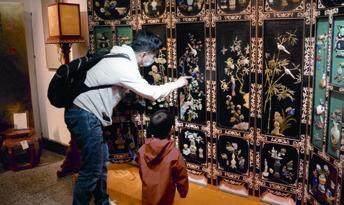Old Craftsmanship,New Value
2022-05-13ByMaLi
By Ma Li
‘When the greasy filth is wiped off, those vessels appear in front of me, beaming and shining. I feel like I am traveling back to ancient times to talk with my ancestors,” Hou Xue says proudly whenever he mentions repairing and restoring cultural relics in the Palace Museum in Beijing. Hou is a representative inheritor of the state-level intangible cultural heritage of producing gold-inlaid lacquerware. “It is the honor of a lifetime to repair these precious ancient vessels,”he said.
Hou majored in art and design at North China University of Technology in Beijing. “At that time, I hoped to find a job in a newspaper or a periodical as an art editor or designer,” said Hou. As chance would have it, he met Bai Qun, a member of the state-level intangible cultural heritage representative inheritor program for the production of gold-inlaid lacquerware, who invited Hou to visit an exhibition of palace arts.
Elegant and simple folding screens, graceful cabinets and other works in the exhibition appealed to Hou, and more importantly, he was surprised and deeply impressed by the exquisite craftsmanship. Touching the furniture and vessels used to be reserved for royal families, Hou felt he was dreaming: He could feel that the craftsmanship involved in making these things has been well-preserved. “I was so impressed by these vessels, that when Bai asked whether I would like to learn this craft, I nodded without hesitation. This visit to the exhibition hall changed my career goals,” said Hou.
Chinese lacquerware dates back approximately 8,000 years. Gold-inlaid lacquerware is an important part of this craft and was once reserved for the royal families of history. Beijing, an ancient capital city for multiple dynasties, is the major production base for lacquerware.
The gradual development of lacquerware craftsmanship over approximately 700 years during the three Beijing-based dynasties, Yuan, Ming and Qing, laid a foundation for its modern development. When the Qing Dynasty collapsed in 1911, many of the craftsmen once working in royal workshops were forced to begin selling their wares in ordinary society. They contributed to the rise of the eight Beijing-style handicrafts, including jade carving, ivory carving and carved lacquerware in Beijing. The art and style of gold-inlaid lacquerware in Beijing, as well as the way it is taught and passed on, have their roots in royal craftsmanship of the Ming and Qing dynasties.
At Bai’s recommendation, Hou formally joined Beijing Gold Lacquer Inlaid Co. Ltd. in 2009 as an apprentice in the gold-inlaid lacquerware workshop. Every day, he got up at 4 a.m. in order to be at work by 8 a.m., and took a bus to go back to his dormitory in the evening. In summer, it was scorching in the workshop, while in winter, it was freezing.
Through several years of dedicated study and practice, Hou has won many honors and titles. He says that accidentally taking on his current job has brought him a career he will cherish for the rest of his life.
Hou worked in the Palace Museum from 2014 to 2016, focusing on protective restoration and replication of lacquerware collected. This experience is demanding and even sometimes torturous, but is also a precious opportunity to strengthen his craftsmanship.
“For example, when touching up the blue color that has worn away from objects over time, we need to apply the lacquer seven to eight times, with the color going from light to dark to reach color saturation. Additionally, work on the same piece must be undertaken at the same time in the same location and under the same weather conditions in order to avoid color differences between the repaired part and the old part,” explained Hou.
These are seemingly simple steps, but they require a high-level of profes- sionalism, and also the knowledge of every ancient vessel, he said. Cultural relics reflect the aesthetic level of a certain historical period. They are still charming and appealing even today because they are tangible embodiments of excellent Chinese culture and first-level craftsmanship handed down through centuries. “My reverence for ancient craftsmanship and wisdom grows with each passing day.”
If classified in terms of functions, Beijing gold-inlaid lacquerware can fall into different categories, such as vessels, furniture, folding screens, plaques and mural decorations. In the Palace Museum, most lacquerware furniture and vessels were made in the gold-inlaid form. These include the dragon throne in the Hall of Supreme Harmony, and almost all beds, desks, and toilet cases in the imperial palace. Hou is proud of his company’s long-term cooperation with the Palace Museum. “It’s because we have inherited the best skills in this technique and we are making innovations on this solid basis,” he said.
Beijing Gold Lacquer Inlaid Co. Ltd. boasts a history of 66 years. It is an important platform for the protection and inheritance of the skill of making goldinlaid lacquerware. Hou’s personal development in this technical arena is to a large extent benefiting from a good intergenerational learning model. When he was alive, Bai Deyuan, a fifth-generation inheritor of the craft and Bai Qun’s father, used to emphasize the importance of making rational and effective innovations on the basis of inheriting traditional craftsmanship. By innovation, Bai Deyuan meant innovation in response to the needs of the era as well as restoration and replication of ancient techniques lost for years.

In early 2022, the company joined hands with local museums and cultural organizations to launch handcrafted watches, which are wildly popular with consumers. The highlight of these watches lies in their appearance, which combines Po-phase flowers, highly favored in the Tang Dynasty (618-907) as a symbol of auspiciousness, and the artistic concept of Maurits Cornelis Escher, a famous Dutch printmaker. This watch is a limited edition and, thanks to its combination of Chinese and Western styles, was soon sold out after being put on the market. Hou was thus inspired by this experience: “Excellent intangible cultural heritage works are not those thrown into museums for exhibition, but those that live up to modern aesthetic level and modern life,” he said.
Hou believes that the gauge for a successful intangible cultural heritage item is foremost that this item can produce value and bring profits. “If consumers are not interested in such works and inheritors can’t earn a living by doing the job, then these works are valueless and the heritance is worthless,”he said. For a business to attract young successors to join, it must be lucrative, and this is also the way to address the current shortage of innovation capacity and talents in this cultural area. BR
